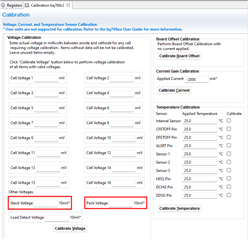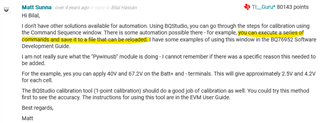Other Parts Discussed in Thread: BQSTUDIO,
Tool/software:
Hi,
Background:
Digging into the E2E forum I found that the python script provided in the "BQ769x2 Calibration and OTP Programming Guide" is not usable as-is due to TI's proprietary/internal library "bqcomm". Therefore, we've decided to use the bqStudio software to perform the Pack Voltage, Stack Voltage, and the Pack Current calibrations.
Question:
1. Is there a separate guide that describes how to perform calibration using bqStudio?
2. For voltage calibration, if I only want to calibrate the Pack and Stack Voltages, should I enter the applied voltage in the corresponding fields and then click the "Calibrate Voltage" button, leaving all other fields empty?

3. For bqStudio to detect the device, does the device need to retain its default I2C address? Our BMS features two BQ76952 chips, and one of them will be assigned a new address during the OTP process. With that in mind, should I perform the calibration before changing the I2C address through OTP, while both devices are still detectable by bqStudio?
Best regards,
Kyungjae Lee


